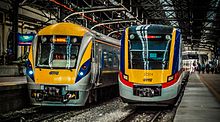Rail transport in Malaysia
| Rail transport in Malaysia | |
|---|---|

Class 91 of KTM ETS for Intercity Express and Class 92 of KTM Komuter at Kuala Lumpur Railway Station.
|
|
| Operation | |
| National railway | Keretapi Tanah Melayu |
| Major operators |
|
| Statistics | |
| Ridership | +200000 people daily (2013) |
| System length | |
| Total | 1,833 kilometres (1,139 mi) |
| Double track | 767 km (477 mi) |
| Electrified | 767 km (477 mi) |
| High-speed | 336.9 km (209.3 mi) |
| Track gauge | |
| Main | 1,000 mm (3 ft 3 3⁄8 in) |
| High-speed |
1,000 mm (3 ft 3 3⁄8 in) 1,435 mm (4 ft 8 1⁄2 in) |
|
Metre gauge 1,000 mm (3 ft 3 3⁄8 in) |
1,776 km (1,104 mi) |
|
Standard gauge 1,435 mm (4 ft 8 1⁄2 in) |
57 km (35 mi) |
Rail transport in Malaysia comprises heavy rail (including commuter rail), light rapid transit (LRT), monorail, airport rail link and a funicular railway line. Heavy rail is mostly used for intercity passenger and freight transport as well as some urban public transport, while LRTs are used for intra-city urban public transport and some special uses, such as transporting passengers between airport buildings. There are two commuter rail services linking Kuala Lumpur with the Kuala Lumpur International Airport. The sole monorail line in the country is also used for public transport in Kuala Lumpur, while the only funicular railway line is in Penang.
The railway network covers most of the 11 states in Peninsular Malaysia. In East Malaysia, only the state of Sabah has railways. The network is also connected to the Thai railway 1,000 mm (3 ft 3 3⁄8 in) network in the north. If the Burma Railway is rebuilt, services to Myanmar, India, and China could be initiated.
The intercity railway network in Peninsular Malaysia consists of two main lines: The KTM West Coast Line between Singapore and Padang Besar, Perlis, on the Malaysian-Thai border, and the KTM East Coast Line between Gemas in Negeri Sembilan and Tumpat in Kelantan. There are also several branch lines – between Kuala Lumpur and Port Klang, Batu Junction and Batu Caves, Bukit Mertajam and Butterworth, Tapah Road and Teluk Intan, Kempas and Tanjung Pelepas, Kempas and Pasir Gudang, and between Pasir Mas and Rantau Panjang. The entire 1,699 km network uses 1,000 mm (3 ft 3 3⁄8 in) metre gauge tracks. The network uses ballasted setup with locally manufactured concrete sleepers. Since the early 1980s, companies formed via international collaboration, such as Mastrak Sdn Bhd had been producing these sleepers via technology transfer. In the five years period of 1982-1987 alone, it was estimated that about 500,000 pieces of sleepers had been laid for the Kerdau-Jerantut and Sungai Yu-Tumpat lines, giving clear preference due to its advantages over wooden sleepers. This was also evident in the changes made by Sabah State Railway in 2006 for the network under their control.
...
Wikipedia
